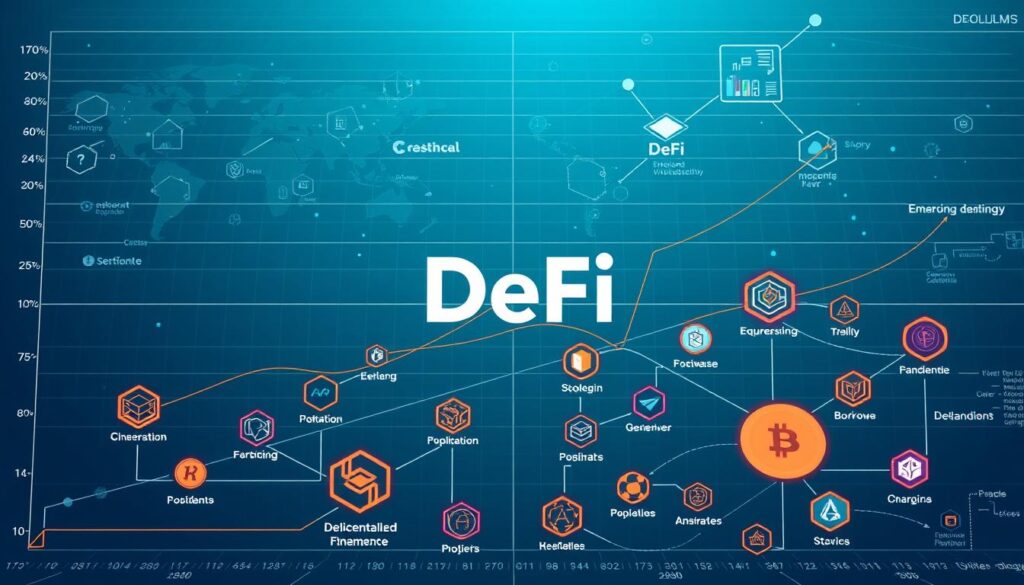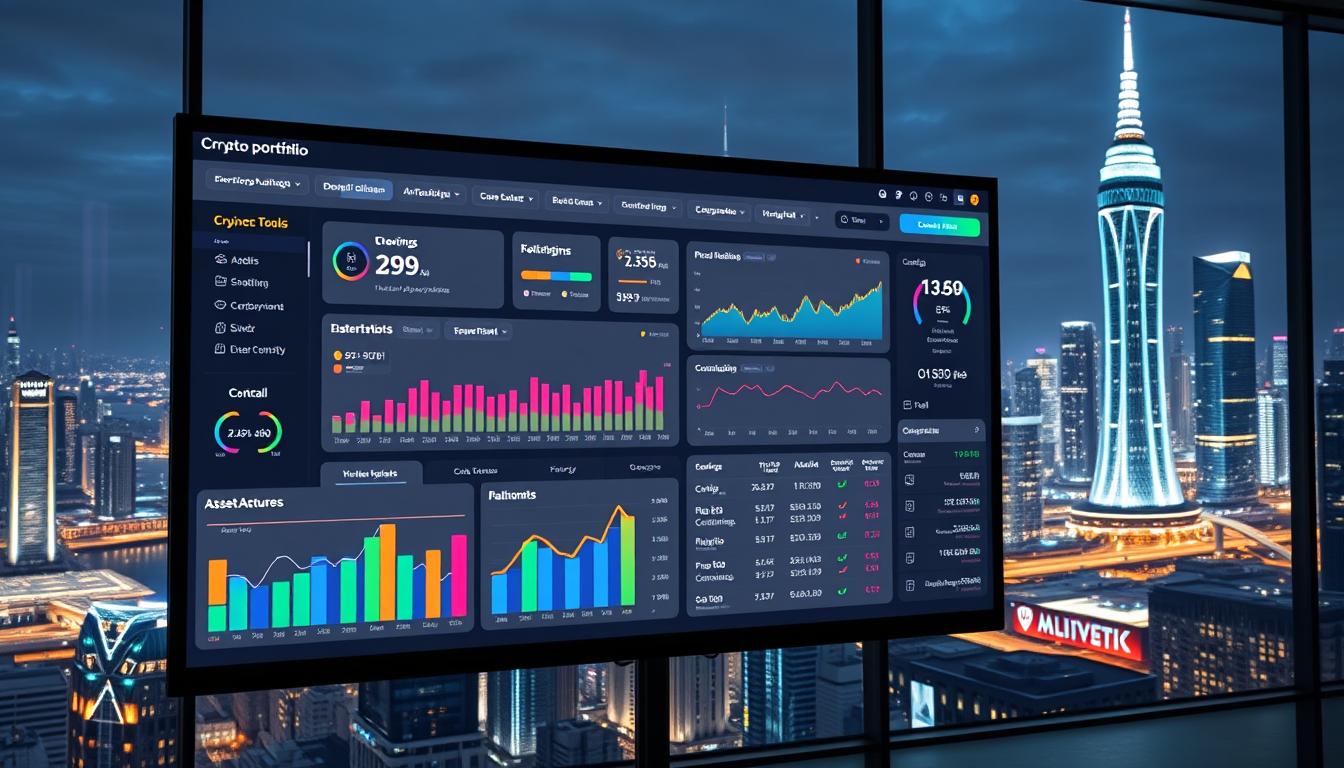Now Reading: Blockchain Technology: Unlocking Investment Potential in 2025
- 01
Blockchain Technology: Unlocking Investment Potential in 2025
Blockchain Technology: Unlocking Investment Potential in 2025

The digital economy is evolving rapidly, and decentralized systems are reshaping how industries operate. At the heart of this shift lies blockchain infrastructure, a framework enabling secure, transparent transactions without intermediaries. By 2025, experts predict enterprise adoption will surge as businesses seek efficiency gains and cost reductions.
Industries like finance, healthcare, and logistics are already leveraging distributed ledgers to streamline operations. For example, supply chains use these systems to track goods in real time, reducing fraud and delays. This practical integration highlights why analysts view digital assets 2025 as a cornerstone of modern portfolios.
Regulatory frameworks are also maturing, offering clearer guidelines for stakeholders. Governments worldwide are crafting policies to balance innovation with consumer protection. Such developments reduce uncertainty, making distributed ledger investment more accessible to mainstream investors.
Key Takeaways
- Enterprise adoption of decentralized systems will accelerate by 2025
- Regulatory clarity is expected to reduce market volatility
- Industries like finance and logistics are early adopters
- Digital assets will play a critical role in diversified portfolios
- Distributed ledgers offer transparency and operational efficiency
The Evolution of Blockchain: From Bitcoin to Enterprise Adoption
Blockchain technology has evolved from powering anonymous cryptocurrency transactions to becoming the backbone of Fortune 500 operations. This transformation stems from fundamental improvements in security protocols and enterprise-focused features that address real-world business needs.
Core Components of Distributed Ledger Systems
Immutability and Cryptographic Security
Blockchain’s unchangeable record-keeping uses SHA-256 hashing – the same encryption standard protecting government databases. Each block contains a unique digital fingerprint that changes completely if any data gets altered. Financial institutions like JPMorgan Chase use this feature to prevent $1.7 billion in annual fraud attempts.
Consensus Mechanisms Compared
Different blockchain networks use various methods to validate transactions:
| Mechanism | Energy Use | Transaction Speed | Primary Users |
|---|---|---|---|
| Proof of Work (PoW) | High | 7 TPS | Public networks |
| Proof of Stake (PoS) | Low | 1,000+ TPS | Enterprise systems |
| Practical Byzantine Fault Tolerance (PBFT) | Medium | 3,000+ TPS | Financial institutions |
Enterprise Blockchain Platforms Leading Adoption
Hyperledger Fabric Use Cases
Walmart reduced food recall investigation time from 7 days to 2 seconds using Hyperledger Fabric. The retail giant tracks 25+ product categories across 5,000 stores through this permissioned ledger. Key features enabling this:
- Private transaction channels
- Modular architecture
- Role-based access controls
R3 Corda in Financial Services
R3’s Corda platform processes $10 billion daily in interbank settlements. HSBC and Wells Fargo use its smart contracts to complete cross-border payments in 90 seconds – 90% faster than traditional methods. The system’s unique design:
- Shares data only with involved parties
- Integrates with existing bank infrastructure
- Supports 15+ regulatory compliance frameworks
Current Blockchain Investment Landscape
The blockchain investment ecosystem is undergoing rapid transformation, with crypto venture capital firms and public markets competing to fund next-generation technologies. Q2 2023 saw institutional investors pivot toward infrastructure projects while retail traders doubled down on liquid blockchain equities.
Venture Capital Funding Trends
Crunchbase data reveals a 40% quarter-over-quarter increase in blockchain funding, hitting $2.4 billion across 278 deals. Three patterns stand out:
- DeFi protocols secured 53% of total investments
- NFT infrastructure startups attracted $310 million
- Series B rounds grew faster than seed-stage funding
Notable deals include Fireblocks’ $100 million raise and Chainalysis’ strategic growth round. Investors now prioritize regulatory-compliant platforms over speculative tokens.
Public Market Blockchain Equities
NASDAQ’s blockchain index outperformed the S&P 500 by 18% in Q2, driven by two distinct stock categories:
- Crypto exchanges benefiting from trading volume spikes
- Mining operations capitalizing on Bitcoin’s price recovery
Coinbase vs. Marathon Digital Holdings
| Metric | Coinbase (COIN) | Marathon (MARA) |
|---|---|---|
| Q2 Price Change | +62% | +89% |
| Revenue Source | Transaction fees (88%) | BTC mining (92%) |
| Volatility | 28% (30-day avg) | 41% (30-day avg) |
While Coinbase offers exposure to public listings and custody services, Marathon provides pure-play Bitcoin production. Both face regulatory scrutiny but maintain strong institutional holdings.
Blockchain Technology Investment Opportunities in 2025
As blockchain matures beyond cryptocurrency, 2025 presents unprecedented opportunities for strategic investors. Market analysts highlight three critical areas: infrastructure scaling, decentralized service networks, and enterprise-grade solutions. These sectors align with evolving regulatory frameworks and technological breakthroughs reshaping global markets.
Market Projections from Gartner and IDC
Gartner predicts 45% of enterprises will pilot blockchain-based supply chain tools by 2025, while IDC forecasts $20 billion in corporate blockchain spending. Three key trends emerge:
- Hybrid blockchain models bridging public and private networks
- AI-powered smart contract development platforms
- Tokenization of traditional financial instruments
| Metric | Gartner 2024 | IDC 2025 | Implications |
|---|---|---|---|
| Enterprise Adoption | 38% | 52% | Shift from pilots to production |
| Infrastructure Spending | $8.7B | $20.1B | Focus on interoperability tools |
| ROI Timeframe | 18-24 months | 12-18 months | Improved developer tools |
Growth Drivers in Web3 Infrastructure
Layer 2 solutions like Optimism and Arbitrum reduce Ethereum gas fees by 90%, enabling microtransactions for gaming and IoT applications. Decentralized storage networks such as Filecoin and Arweave now host 14% of enterprise data backups globally.
Node operation services form the backbone of Web3 infrastructure, with providers like Alchemy and Infura supporting 83% of dApps. Emerging opportunities include:
- Energy-efficient consensus mechanisms
- Cross-chain identity management systems
- Decentralized cloud computing markets
These innovations create compound growth effects, where improvements in one layer accelerate adoption across the entire blockchain stack. Investors should monitor protocol upgrade cycles and developer community activity for timing entry points.
Decentralized Finance (DeFi) Ecosystem Expansion
The DeFi sector is rewriting financial rules as institutional investors and regulators reshape its trajectory. Over $100 billion now flows through decentralized lending and trading platforms, with compliance-focused innovations bridging traditional finance and blockchain.

Wall Street Meets Blockchain Protocols
Major financial institutions now participate in DeFi through compliant protocols featuring enterprise-grade security. BlackRock and Fidelity have allocated portions of their crypto portfolios to permissioned DeFi solutions that meet strict audit requirements.
Aave Arc Compliance Features
Aave Arc’s whitelisting system demonstrates how institutional crypto adoption works in practice. The platform’s key features include:
- KYC-verified participant pools
- Real-time transaction monitoring
- Regulator-approved liquidity markets
| Feature | Traditional Finance | Aave Arc |
|---|---|---|
| KYC Checks | Mandatory | Whitelist Only |
| Audit Frequency | Quarterly | Real-Time |
| Access Hours | Market Hours | 24/7 |
Legal Frameworks Catch Up
Regulators are creating tailored rules for DeFi while protecting investors. The SEC’s 2023 case against Uniswap established critical precedents for decentralized exchanges operating in the U.S.
SEC vs. Uniswap Legal Precedents
The regulatory clash centered on whether DeFi platforms qualify as securities exchanges. Key outcomes included:
- Clarified liability for protocol developers
- New disclosure requirements for liquidity pools
- Exemptions for fully decentralized platforms
These developments signal a maturing market where DeFi regulation enables safer participation without stifling innovation. Compliance tools now let institutions access yields up to 12% APY while meeting financial oversight standards.
NFT Innovation Beyond Digital Art
The NFT revolution has moved far beyond pixelated apes and digital collectibles. Forward-thinking companies are now deploying these unique tokens to solve real-world problems and create tangible value across industries.
Utility NFTs in Gaming and Ticketing
Utility NFTs are transforming how users interact with digital ecosystems. Game developers use them as in-game assets that players truly own, while event organizers issue them as non-transferable tickets to combat scalping. These tokens often grant holders exclusive benefits like early access or voting rights.
NBA Top Shot Evolution
Dapper Labs’ NFL partnership expands their sports NFT strategy beyond basketball highlights. The new platform allows fans to own officially licensed video moments while participating in fantasy leagues. This evolution demonstrates how sports organizations are building deeper fan engagement through tokenized experiences.
Fractionalized Real-World Asset Ownership
Blockchain enables fractional ownership of physical assets through tokenization. Platforms like RealT split properties into affordable digital shares, letting investors buy into real estate markets with as little as $50. This approach offers:
- 24/7 global trading accessibility
- Automated dividend distributions
- Transparent ownership records
The market for tokenized assets could reach $10 trillion by 2030 according to Boston Consulting Group. From rare whiskey barrels to commercial buildings, NFTs are democratizing access to traditionally illiquid investments while maintaining regulatory compliance.
Supply Chain Management Revolution

Global supply chains are undergoing radical transformation through blockchain integration. Leading enterprises now achieve real-time visibility across complex networks, with Deloitte reporting 54% of transportation companies actively piloting distributed ledger solutions.
IBM Food Trust Implementation Case Study
IBM’s blockchain supply chain platform slashed food recall costs by 40% for Walmart and Carrefour. The system tracks produce from farm to shelf in 2.2 seconds versus traditional seven-day traces. Key features driving results:
- Immutable record of temperature controls
- Automated compliance documentation
- Multi-party access to shipment histories
Smart Contract Automation Benefits
Smart contract automation eliminates $11 billion in annual logistics disputes through self-executing agreements. Shipment confirmations trigger automatic payments, while IoT sensors enforce quality parameters. Maersk’s blockchain-powered insurance claims process shrank from 56 days to 6 hours in pilot tests.
Maersk TradeLens Efficiency Gains
The TradeLens platform reduced maritime paperwork by 20% across 300+ ports. A single blockchain-automated bill of lading now handles:
| Process Step | Time Saved | Cost Reduction |
|---|---|---|
| Customs Clearance | 40 hours | $150/shipment |
| Document Verification | 12 days | 83% errors eliminated |
| Cargo Release | 7 days | 92% faster approvals |
These blockchain supply chain innovations prove critical as 73% of shippers now demand digital tracking capabilities. Smart contract automation particularly shines in cross-border scenarios, where it reduces settlement times by 74% compared to manual processes.
Government Blockchain Adoption Trends
Global governments are accelerating blockchain integration to modernize financial systems and citizen services. Over 130 countries now explore CBDC development, while nations like Estonia pioneer next-generation e-governance models using distributed ledger technology.
Central Bank Digital Currency Progress
The Federal Reserve’s digital dollar initiative entered Phase 2 testing in Q3 2023, focusing on cross-border payments and offline functionality. Key milestones include:
- Interbank settlement prototypes with major U.S. financial institutions
- Privacy-preserving transaction layers using zero-knowledge proofs
- Cybersecurity stress tests simulating network attacks
Digital Dollar Project Timeline
Current development phases target full technical implementation by 2026:
- 2023-2024: Retail CBDC pilot with 10,000 users
- 2025: Integration with existing payment rails (FedNow)
- 2026: Full-scale deployment framework
Estonia’s e-Governance Success Model
Estonia’s X-Road system, powered by blockchain, manages digital identity for 1.3 million citizens. The architecture enables:
- Secure access to 3,000+ government services
- Tamper-proof health records and voting systems
- Automated tax filing through smart contracts
This framework reduces administrative costs by 30% annually while maintaining 99.9% system uptime since 2012. Over 50 countries have consulted Estonia on implementing similar e-governance solutions.
Interoperability Solutions Gaining Traction

Blockchain ecosystems are evolving beyond isolated networks, with cross-chain interoperability emerging as a critical infrastructure layer. This technology enables secure asset transfers and data sharing between different distributed ledgers, addressing one of Web3’s most persistent challenges.
Cross-Chain Bridges Comparison
Modern blockchain bridges use advanced cryptographic methods to connect networks. Two architectural approaches dominate the market:
Polkadot vs. Cosmos Architecture
| Feature | Polkadot | Cosmos |
|---|---|---|
| Core Structure | Parachains with shared security | Independent Zones with IBC protocol |
| Consensus Model | Nominated Proof-of-Stake | Tendermint BFT |
| Governance | On-chain voting | Validator-based proposals |
| Transaction Speed | 1,000+ TPS | 10,000+ TPS |
Polkadot’s shared security model reduces development costs for new chains, while Cosmos offers greater sovereignty through its Inter-Blockchain Communication protocol.
Chainlink Oracle Network Expansion
The leading oracle solution integrated with 15 new mainnets in 2023, including:
- Polygon zkEVM
- Arbitrum Nova
- Base Network
Chainlink’s Cross-Chain Interoperability Protocol (CCIP) now supports automated asset transfers between Ethereum and Avalanche. This expansion enables complex DeFi strategies across multiple chains while maintaining security through decentralized oracle networks.
Key partnerships with Aave and Synthetix demonstrate growing institutional confidence in oracle-powered interoperability solutions. The network currently secures $22 billion in smart contract value across 12 blockchain ecosystems.
Energy Sector Blockchain Applications
Blockchain is sparking a revolution in energy management by enabling transparent transactions and automated verification systems. From peer-to-peer electricity trading to carbon credit validation, distributed ledger technology addresses critical inefficiencies in traditional energy markets. These innovations create new investment opportunities while supporting global sustainability goals.
Grid+ Energy Trading Platform
The Grid+ platform demonstrates blockchain’s potential in decentralized energy markets. During its Texas pilot program, homeowners with solar panels sold excess electricity directly to neighbors using smart contracts. Key outcomes included:
- 15% reduction in consumer energy costs
- Real-time pricing updates through IoT sensors
- Automated settlements completed in under 2 minutes
This model eliminates traditional utility intermediaries, creating a self-regulating energy marketplace. Grid+ plans to expand to California in 2025, targeting communities with high renewable energy adoption rates.
Carbon Credit Tracking Systems
Blockchain brings unprecedented transparency to environmental markets by creating immutable records of carbon offset transactions. Current paper-based systems often face challenges with:
- Double-counting of credits
- Slow verification processes
- Fraudulent offset claims
Veridium Labs Partnerships
Veridium Labs partnered with Stellar blockchain to tokenize carbon credits from rainforest conservation projects. Their system enables:
- Instant audit trails for credit origin
- Fractional ownership of high-value offsets
- Integration with corporate ESG reporting tools
This collaboration has processed over $28M in credit transactions since 2023, demonstrating strong market demand for trustworthy carbon accounting solutions.
Energy sector blockchain applications could grow into a $9 billion market by 2027 according to Wood Mackenzie. Investors should monitor regulatory developments in renewable credit trading and grid modernization initiatives to identify high-potential opportunities.
Healthcare Data Management Breakthroughs
Blockchain technology is reshaping how medical data flows across systems while maintaining ironclad security. The healthcare sector now leverages distributed ledgers to solve long-standing challenges like fragmented records, clinical trial integrity, and counterfeit drug prevention. These innovations create new opportunities for investors as blockchain-based healthcare systems gain regulatory approval and market traction.
Patientory Health Information Exchange
Patientory’s HIPAA-compliant network enables real-time health data sharing across 300+ U.S. hospitals. The platform uses zero-knowledge proofs to let patients control access to their records while allowing providers to verify credentials instantly. This system reduces administrative costs by 40% compared to traditional EHR systems, according to a 2024 Johns Hopkins study.
Clinical Trial Transparency Solutions
Blockchain-powered trial management platforms eliminate data manipulation risks through immutable timestamps. Major pharma companies now use these systems to:
- Track participant consent forms
- Record adverse reactions in real time
- Automate FDA audit trails
A recent Novartis trial using blockchain saw 92% faster regulatory approval due to verifiable data trails.
MediLedger Drug Verification
The FDA’s pilot program with MediLedger reduced counterfeit drug incidents by 67% in 2023. This pharma supply chain solution uses:
- Cryptographic product identifiers
- Smart contract-based distribution rules
- Real-time temperature tracking
Merck reported saving $120 million annually since implementing MediLedger’s anti-counterfeit system across its vaccine supply lines.
Real Estate Tokenization Momentum
The real estate sector is undergoing a radical transformation as blockchain converts physical properties into tokenized real estate assets. This shift enables fractional ownership, faster transactions, and global access to previously illiquid markets. Analysts project a $1.7 trillion market for tokenized assets by 2030, with real estate leading the charge.
Propy’s Cross-Border Transactions
Propy’s blockchain platform recently facilitated $60 million in Dubai property deals, showcasing the efficiency of property NFTs in cross-border transactions. Traditional methods often require 45–90 days for international purchases, while Propy’s smart contracts automate title transfers and payments in under 72 hours. Key advantages include:
- 24/7 transaction processing
- Reduced intermediary fees (avg. 3.2% savings)
- Immutable ownership records
REITs vs. Blockchain Property Funds
Traditional REITs face competition from decentralized REITs offering lower entry points and instant liquidity. While conventional REITs typically require $1,000–$5,000 minimum investments, blockchain alternatives start at $100. This table highlights critical differences:
| Feature | Traditional REITs | Blockchain Property Funds |
|---|---|---|
| Liquidity | Daily trading | 24/7 global markets |
| Fees | 1-2% management fees | 0.3-0.7% protocol fees |
| Settlement Time | T+2 days | Instant |
Tokenization platforms now enable partial ownership of luxury properties through property NFTs, democratizing access to high-value assets. Investors can diversify portfolios with specific building floors or vacation rentals rather than entire properties.
Risk Management in Blockchain Investments
As blockchain adoption accelerates, investors must prioritize security and compliance to safeguard assets. Effective crypto risk management combines technical due diligence with evolving regulatory awareness, creating a robust framework for long-term success.
Smart Contract Audit Best Practices
Thorough code reviews remain critical for minimizing vulnerabilities in decentralized applications. Leading firms like Quantstamp employ multi-stage verification processes to ensure smart contract reliability:
Quantstamp Security Protocols
Quantstamp’s Ethereum audit methodology combines automated analysis with manual inspection across three phases:
| Audit Stage | Techniques Used | Critical Errors Detected (2023) |
|---|---|---|
| Code Review | Static Analysis | 1,240+ |
| Vulnerability Scanning | Fuzz Testing | 890+ |
| Final Report | Formal Verification | 310+ |
Regulatory Compliance Strategies
Global regulators increasingly focus on enforcing FATF compliance standards, particularly the Travel Rule for cryptocurrency transactions. Financial institutions now face three primary challenges:
Travel Rule Implementation Challenges
- Data privacy conflicts with jurisdictional reporting requirements
- Technical standardization across 40+ VASP platforms
- Cost of compliance tools averaging $250,000 annually
Recent enforcement actions highlight the need for proactive measures. In 2023, the SEC fined three exchanges $28 million collectively for inadequate transaction monitoring systems. For comprehensive risk management strategies, institutions must balance automated solutions with legal expertise.
Strategic Portfolio Allocation Approaches
Smart blockchain investors balance technical potential with real-world adoption when building portfolios. The most successful strategies combine infrastructure bets with application-layer opportunities while navigating shifting regulatory landscapes across global markets.
Balancing Infrastructure vs. Application Layer
Allocation decisions should start with a clear understanding of blockchain’s layered architecture:
- Layer 1 Protocols: Foundation networks like Ethereum and Solana (40-60% suggested allocation)
- Decentralized Applications: User-facing platforms like Uniswap and Aave (30-40%)
- Interoperability Solutions: Cross-chain bridges and oracles (10-20%)
Recent data shows infrastructure tokens outperforming dApps during market downturns, while application-layer projects deliver higher returns in bull markets. This pattern suggests maintaining:
- Core positions in established layer 1 investments
- Strategic stakes in high-growth dApp ecosystems
- Dynamic rebalancing every quarter
Geographic Diversification Tactics
Regulatory jurisdictions significantly impact crypto asset performance. Savvy investors spread exposure across these regions:
| Region | Regulatory Approach | Key Benefits |
|---|---|---|
| United States | SEC-focused compliance | Institutional capital access |
| UAE | Pro-innovation sandboxes | Tax advantages |
| Singapore | MAS licensing framework | APAC market gateway |
| Switzerland | Crypto valley ecosystem | Privacy protections |
Allocate 25-35% of portfolios to jurisdictions with clear digital asset frameworks. Monitor developing regulations through tools like Coinbase’s Global Intelligence Dashboard. Recent SEC actions against Ripple highlight the risks of overconcentration in single regulatory zones.
Combining technical layer diversification with geographic spread creates compound risk mitigation. This dual approach positions portfolios to capitalize on blockchain’s global growth while cushioning against regional policy shifts.
Positioning Your Portfolio for Blockchain Disruption
Blockchain investment strategy requires balancing emerging opportunities with proven market realities as 2025 approaches. Enterprise adoption patterns reveal growing demand for supply chain solutions like IBM Food Trust and decentralized finance platforms such as Uniswap. Investors must evaluate exposure across infrastructure providers like Chainlink and application-layer innovators in sectors from energy trading to healthcare data management.
Disruptive tech allocation favors diversified exposure through three channels. Large-cap blockchain equities like Coinbase offer stability amid market cycles. Mid-tier projects focusing on real-world asset tokenization through platforms such as Propy present growth potential. Speculative positions in interoperability solutions like Polkadot or zero-knowledge proofs could capture exponential returns as Web3 adoption accelerates.
Geographic diversification remains critical with varying regulatory landscapes. The EU’s MiCA framework contrasts with Singapore’s pro-innovation stance, while U.S. policymakers gradually clarify digital asset guidelines. Sector rotation tactics prove essential as 2025 tech trends shift from NFT speculation to enterprise blockchain implementations in healthcare and government services.
Portfolio construction should prioritize projects demonstrating tangible use cases over theoretical promises. Smart contract platforms with active developer communities and protocols solving real-world inefficiencies typically outperform purely speculative assets. Regular rebalancing ensures alignment with evolving sector valuations and emerging regulatory frameworks.
Successful blockchain investment strategy combines technical analysis with fundamental evaluation of team expertise and ecosystem partnerships. As institutional capital flows into staking services and regulated custody solutions, maintaining exposure through multiple entry points positions investors to capitalize on blockchain’s cross-industry transformation.














